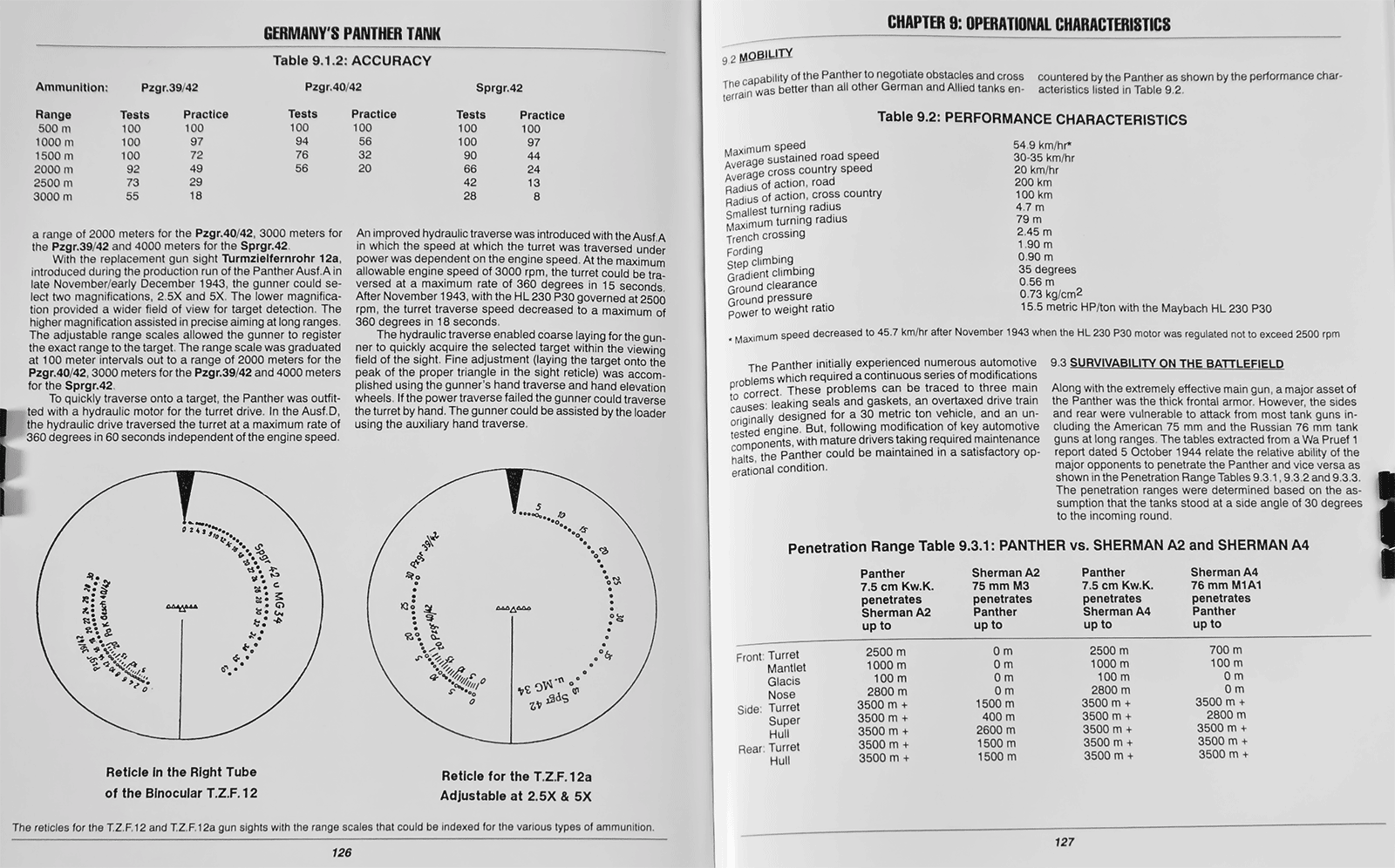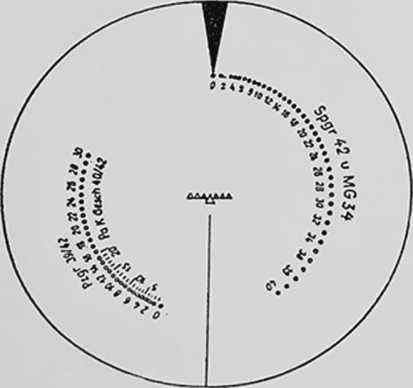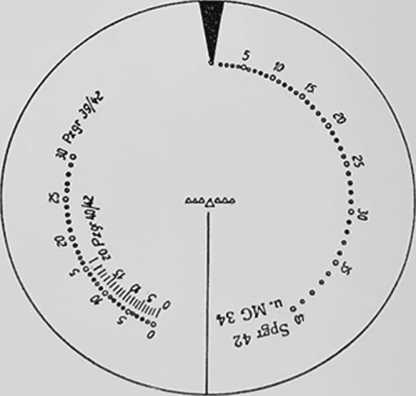065

GERMANY'S PANTHER TANK
Table 9.1.2: ACCURACY
|
Ammunition: |
Pzgr.39/42 |
Pzgr.40/42 |
Sprgr.42 | |||
|
Rangę |
Tests |
Practlce |
Tests |
Practlce |
Tests |
Practlce |
|
500 m |
100 |
100 |
100 |
100 |
100 |
100 |
|
1000 m |
100 |
97 |
94 |
56 |
100 |
97 |
|
1500 m |
100 |
72 |
76 |
32 |
90 |
44 |
|
2000 m |
92 |
49 |
56 |
20 |
66 |
24 |
|
2500 m |
73 |
29 |
42 |
13 | ||
|
3000 m |
55 |
18 |
28 |
8 | ||
a rangę of 2000 meters for the Pzgr.40/42. 3000 meters for the Pzgr.39/42 and 4000 meters for the Sprgr.42
With the replacement gun sight TUrmzielfernrohr 12a. introduced during the production run of the Panther Ausf. A in late November/early December 1943, the gunner could se-lect two magnifications, 2 5X and 5X. The lower magmfica-tion provided a wider field of view for target detection. The higher magnification assisted in precise aiming at long ranges. The adjustable rangę scales allowed the gunner to register the exact rangę to the target The rangę scalę was graduated at 100 meter intervals out to a rangę of 2000 meters for the Pzgr.40/42.3000 meters for the Pzgr.39/42 and 4000 meters for the Sprgr.42
To quickly traverse onto a target, the Panther was outfit-ted with a hydraulic motor for the turret drive. In the Ausf.D, the hydraulic drive traversed the turret at a maximum ratę of 360 degrees in 60 seconds independent of the engine speed.
An improved hydraulic traverse was introduced with the Ausf . A in which the speed at which the turret was traversed under power was dependent on the engine speed. At the maximum allowable engine speed of 3000 rpm, the turret could be tra-versed at a maximum ratę of 360 degrees in 15 seconds After November 1943, with the HL 230 P30 governed at 2500 rpm, the turret traverse speed decreased to a maximum of 360 degrees in 18 seconds
The hydraulic traverse enabled coarse laying for the gunner to quickly acquire the selected target within the viewing field of the sight. Fine adjustment (laying the target onto the peak of the proper triangle in the sight reticle) was accom-plished using the gunner’s hand traverse and hand elevation wheels. If the power traverse failed the gunner could traverse the turret by hand. The gunner could be assisted by the loader using the auxiliary hand traverse.


Reticle In the Rlght Tubę of the BInocular T.Z.F.12
Reticle for the T.Z.F.12a Adjustable at 2.5X & 5X
The reticles for the T.Z.F.12 and T.Z.F.12a gun sights with the rangę scales that could be mdexed for the vanous types of ammunition.
CHARTER 9: OPERATIONAL CHARACTERISTICS
9 2M5BIUTY
capability of the Panther to negotiate obstacles and cross countered by the Panther as shown by the performance char-terrain was better than all other German and Allied tanks en- acteristics listed in Table 9.2
Table 9.2: PERFORMANCE CHARACTERISTICS
Av«Se"susS?ed road speed A e-age cross country speed Sadius of action. road
Badiusofaction. cross country
smallest turning radius Snutnturningradius Trencti Crossing Fording Step climbmg
Gradient climbing Ground clearance Ground pressure Power to weight ratio
54 9 km/hr*
30-35 km/hr 20 km/hr 200 km 100 km 4.7 m 79 m 2.45 m 1.90 m 0.90 m 35 degrees 0 56 m 0.73 kg/cm2
15.5 metric HP/ton with the Maybach HL 230 P30
Maximum
speed decreased to 45.7 km/hr after November 1943 when the HL 230 P30 motor was regulated not to exceed 2500 rpm
The Panther imtially experienced numerous automotive hiems which required a continuous series of modifications correct. These problems can be traced to three mam 10 ses leakmg seals and gaskets. an overtaxed drive train Caamally designed for a 30 metric ton vehicle. and an un-°fśted engine. But. followmg modification of key automotive moonents. with maturę driverstakmg required maintenance nalts^ the Panther could be maintained in a satisfactory op-erational condition.
9.3 SURVIVABIUTY ON THE BATTLEFIELD
Along with the extremely effective main gun. a major asset of the Panther was the thick frontal armor. However, the sides and rear were vulnerable to attack from most tank guns in-cluding the American 75 mm and the Russian 76 mm tank guns at long ranges The tables extracted from a Wa Pruef 1 report dated 5 October 1944 relate the relative ability of the major opponents to penetrate the Panther and vice versa as shown in the Penetration Rangę Tables 9.3 1.9 3 2 and 9.3.3. The penetration ranges were determined based on the as-sumption that the tanks stood at a side angle of 30 degrees to the incoming round.
|
Panther 7.5 cm Kw.K. penetrates Sherman A2 upto |
Sherman A2 75 mm M3 penetrates Panther up to |
Panther 7.5 cm Kw.K. penetrates Sherman A4 upto |
Sherman A4 76 mm M1A1 penetrates Panther up to | |
|
Front Turret |
2500 m |
0 m |
2500 m |
700 m |
|
Mantlet |
1000 m |
0 m |
1000 m |
100 m |
|
Glacis |
100 m |
0 m |
100 m |
0 m |
|
Nose |
2800 m |
0 m |
2800 m |
0 m |
|
Qirtp Turret |
3500 m + |
1500 m |
3500 m + |
3500 m + |
|
Super |
3500 m + |
400 m |
3500 m + |
2800 m |
|
Hull |
3500 m + |
2600 m |
3500 m + |
3500 m + |
|
Bear Turret |
3500 m + |
1500 m |
3500 m + |
3500 m + |
|
Hull |
3500 m + |
1500 m |
3500 m + |
3500 m + |

127
Wyszukiwarka
Podobne podstrony:
GERMAN Y S PANTHEH TANK was almost completed. A model of the motor was complete and was to be sent t
GERMANY S PANTHER TANK The spent MG cartndge tubę pulled out when the n s depressed When the gun was
GERMANYS PANTHER TANK Dn 21 February 1943 a Jak* steer.ng gears) (CHY) :,on Au of
GERMANY S PANTHER TANK I Befehls-Panther Ausf D. Tactical Nr 155. possessed the last changes madę to
GERMANY S PANTHER TANK Drawmg No H-Sk A 86176 dated 7 November 1943 shows a machmegun mount for a Pa
GERMANY S PANTHER TANK Tne omy cnass-s compieted for tne Versuchs-Panther II was captured Dy tne Ame
GERMANYS PANTHER TANK Panther Ausf A (Fgst Nr 152151 produced by Daimler-Benz on 0r about 16 Decembe
GERMANV S PANTHER TANK 7.5 cm Kw.K.42 L 70 Extornal Travel Lock Commandor’8 Cudoi* 021St
GERMANY S PANTHER TANK 4 3.11 CREW COMPARTMENT HEATER AND ENGINE Durmg cold weather. the Kampfraumhe
GERMANYS PANTHER TANK Panzarkampfwagen Panther (7.5 cm Kw.K.42 L.70) (Sd.Ktz.171) An Auafuehrung A w
GERMANYS PANTHER TANK 4 3 13 WATERTLGHT SEALS BEHINB THE GUN MANTLET On 16 March 1944 MNH was mforme
GERMANYS PANTHER TANK Track dOjustment left 48306 48306 Track ad
GERMANY S PANTHER TANK any Panther completed m November The Panthers already prepared for msiallatio
GERMANYS PANTHER TANK As an expedient to mcrease protection against strafing aircraft and splinters
GERMAN Y S PANTHER TANK Rhemmetall designed a Panther turret with a narrow gun mantlet. penscopic gu
GERMANYS PANTHER TANK Above and opposite above A Versuchs-Schmalturm (experimental narrow turret) mo
GERMANYS PANTHER TANK succeed in producmg a single 1 32 m rangefmder before the end ot ihe war Devel
GERMANY S PANTHER TANK In addition. lucky hits on the lower half of the original gun mantlet sometim
GERMANYS PANTHER TANK STATUS OF OPERATIONAL PANTHERS Oparallon ZHadada from 5 to 17 Juty 1043 ICO 10
więcej podobnych podstron